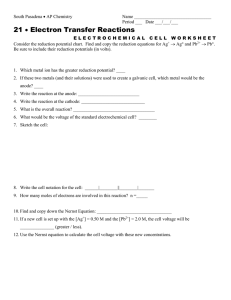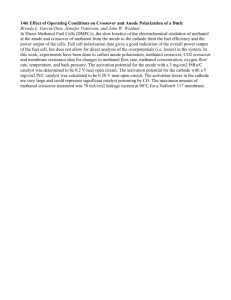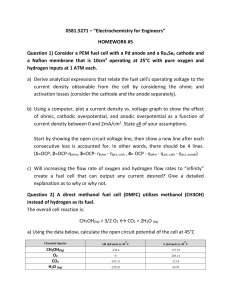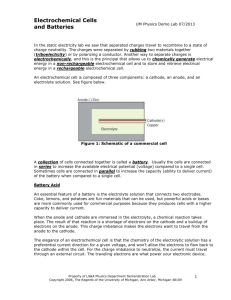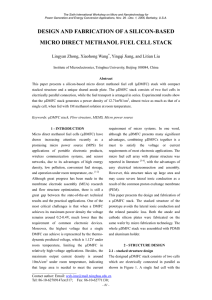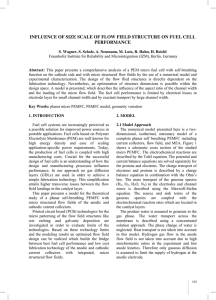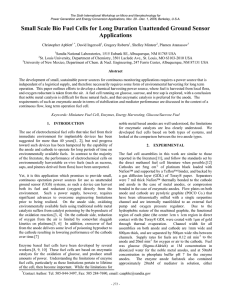Problem Set 4 – Kinetics ...
advertisement
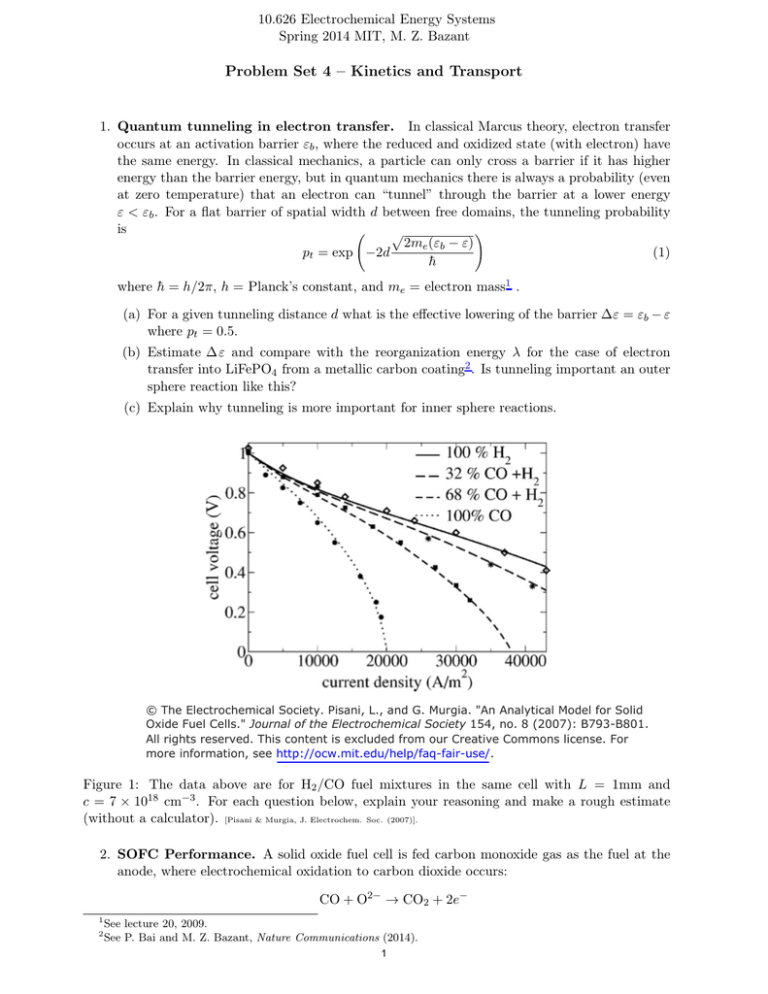
10.626 Electrochemical Energy Systems Spring 2014 MIT, M. Z. Bazant Problem Set 4 – Kinetics and Transport 1. Quantum tunneling in electron transfer. In classical Marcus theory, electron transfer occurs at an activation barrier "b , where the reduced and oxidized state (with electron) have the same energy. In classical mechanics, a particle can only cross a barrier if it has higher energy than the barrier energy, but in quantum mechanics there is always a probability (even at zero temperature) that an electron can “tunnel” through the barrier at a lower energy " < "b . For a flat barrier of spatial width d between free domains, the tunneling probability is ! p 2me ("b - ") pt = exp -2d (1) h̄ where h̄ = h/2⇡, h = Planck’s constant, and me = electron mass1 . (a) For a given tunneling distance d what is the e↵ective lowering of the barrier 6" = "b - " where pt = 0.5. (b) Estimate 6 " and compare with the reorganization energy A for the case of electron transfer into LiFePO4 from a metallic carbon coating2 . Is tunneling important an outer sphere reaction like this? (c) Explain why tunneling is more important for inner sphere reactions. © The Electrochemical Society. Pisani, L., and G. Murgia. "An Analytical Model for Solid Oxide Fuel Cells." Journal of the Electrochemical Society 154, no. 8 (2007): B793-B801. All rights reserved. This content is excluded from our Creative Commons license. For more information, see http://ocw.mit.edu/help/faq-fair-use/. Figure 1: The data above are for H2 /CO fuel mixtures in the same cell with L = 1mm and c = 7 ⇥ 1018 cm-3 . For each question below, explain your reasoning and make a rough estimate (without a calculator). [Pisani & Murgia, J. Electrochem. Soc. (2007)]. 2. SOFC Performance. A solid oxide fuel cell is fed carbon monoxide gas as the fuel at the anode, where electrochemical oxidation to carbon dioxide occurs: 1 2 CO + O2- ! CO2 + 2eSee lecture 20, 2009. See P. Bai and M. Z. Bazant, Nature Communications (2014). 1 (a) Relate Ilim to the CO di↵usivity D in the porous anode, the inlet CO concentration c, and the anode thickness L. (b) Estimate D from the data. (c) Estimate the solid electrolyte Ohmic resistance Rel (in ⌦ ·cm2 ). (d) Estimate the maximum power density Pmax for 100% CO fuel. 3. DMFC fuel crossover. In the direct methanol fuel cell (DMFC), the anode is fed with a methanol-water fuel and produces carbon dioxide, which escapes into the solution. The reaction produces protons, which cross a proton exchange membrane (PEM) to the cathode, where reduction occurs with oxygen gas (from air exposure) to produce water. The half-cell reactions are anode: cathode: net reaction (combustion): CH3 OH + H2 O ! 6H + + 6e- + CO2 3 O2 + 6H + + 6e- ! 3H2 O 2 3 CH3 OH + O2 ! 2H2 O + CO2 2 Consider steady-state 1D di↵usion of methanol with di↵usivity Da in the porous anode of thickness la , and also in the membrane of thickness lm and di↵usivity Dm ⌧ Da , where cM is continuous across the anode/membrane interface. The latter corresponds to “fuel crossover” which is a problem in DMFC, since combustion will rapidly consume any methanol that makes it to the cathode, where we set cM = 0. Let c̄M be the (constant) methanol concentration, just outside the porous anode. (a) Derive the cell voltage, V (I, cM ), neglecting concentration polarization at the anode, cM = c̄M , and any polarization at the cathode. Assume Butler-Volmer kinetics with ↵ = 1/2 and n = 6 electrons transferred. Rescale the anode exchange current to be K0 under standard conditions. (b) What is the limiting current Ilim ? Assume the anode has an active area A. Qualitatively, how will fuel crossover influence the current-voltage relation? (c) Relate cM at the anode/membrane interface to the applied current I. Show that the dimensionless group, ' = Dm la /Da lm , controls the importance of fuel crossover. Derive the cell voltage V (I, c̄M , '). 2 MIT OpenCourseWare http://ocw.mit.edu 10.626 Electrochemical Energy Systems Spring 2014 For information about citing these materials or our Terms of Use, visit: http://ocw.mit.edu/terms.

